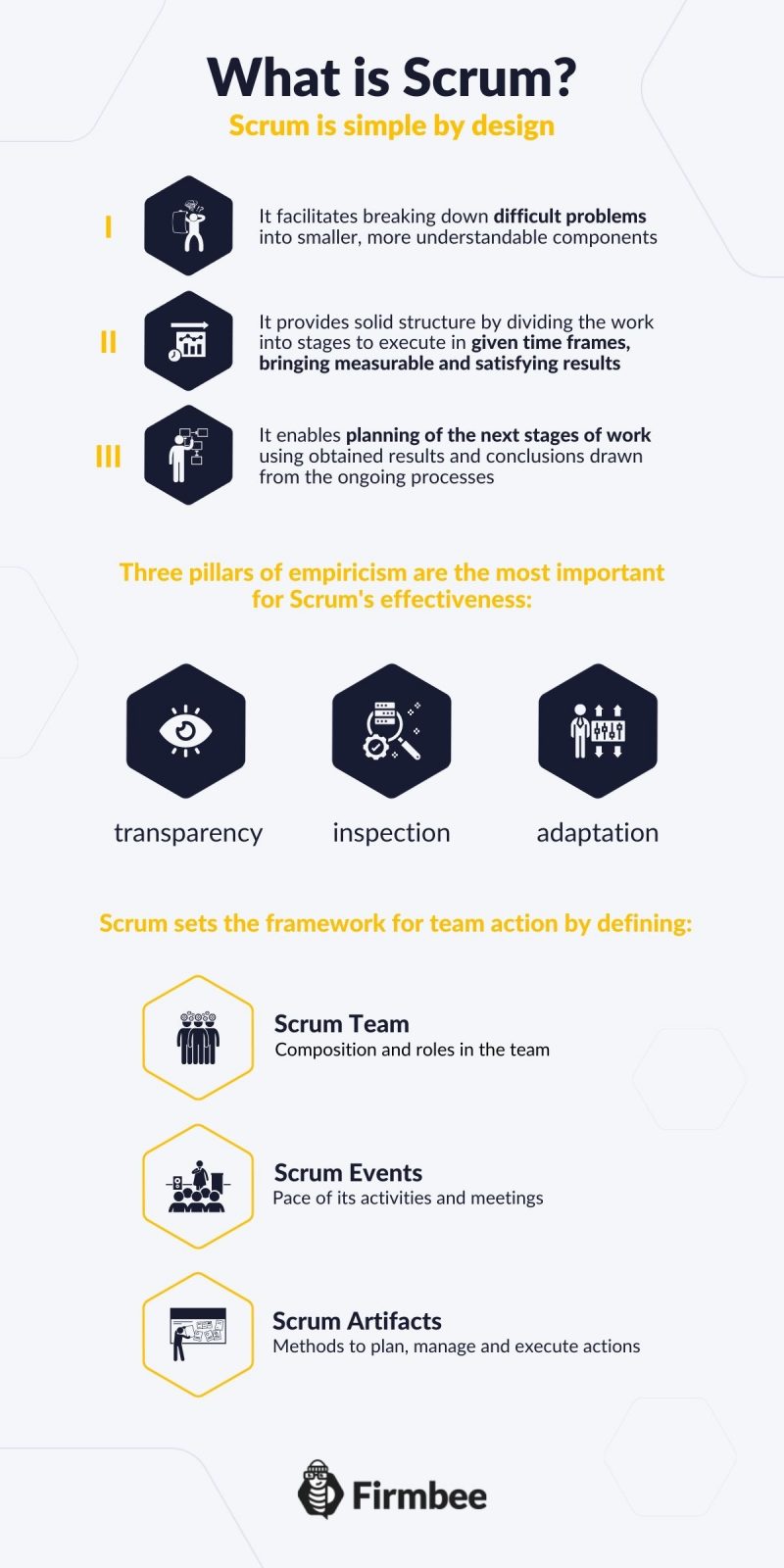Scrum is the most popular way of modern, flexible teamwork management. Not only do software development companies follow its methodology but more and more often teams from various industries such as finance, marketing, HR and creative industries find Scrum practical and applicable. Its ever-growing popularity makes Scrum the most proven organizational framework adapted by teams striving for maximum effectiveness.
What is Scrum – table of contents:
What is Scrum?
To answer this question we have to consider the three following aspects:
- philosophy
- theory
- structure
Scrum is simple by design. First, it facilitates breaking down difficult problems into smaller, more understandable components. Secondly, it provides solid structure by dividing the work into stages to execute in given time frames, bringing measurable and satisfying results. Thirdly, it enables planning of the next stages of work using obtained results and conclusions drawn from the ongoing processes.
Scrum Philosophy
It is important to remember that Scrum is only a framework. It provides guidelines to construct a detailed blueprint of actions to take together with adapted to the needs and capabilities of the team and the organization. Despite its generality, Scrum is finely outlined. The popularity shows its effectiveness, as according to the 15th Annual State Of Agile report from 2021, Scrum principles are used by as many as 66% of teams working following the most modern methodologies. And this percentage increases to more than 80% of teams across disciplines if we add methodologies derived directly from Scrum.
Scrum is comprehensive and serves to optimize teamwork. It offers a clearly-defined starting point. Also, the generality of Scrum principles makes it impossible to simply apply them in an instant. However, the sketchiness of this framework is intentional and flows along with project management practice. The Scrum philosophy focuses on the need for continuous development and reshaping through feedback, reflection and experience. It rejects complex, rigid systems that organize work without taking into account specific realities. The authors of Scrum, Ken Schwaber and Jeff Sutherland, call this principle empiricism in the official Scrum Guide.

Scrum Theory
Scrum theory’s main principle concerns empiricism. It means keeping planning and assumptions to a minimum in favor of relying on experience, observation, and experimentation. It becomes possible and effective thanks to the iterative approach, i.e., working in short cycles, which includes not only working on the product, but also planning it and evaluating the results.
Three pillars of empiricism are the most important for Scrum’s effectiveness:
- transparency – thanks to it, both the people working and Stakeholders (to whom we will devote a separate entry in following article) can easily check the status of the work on Product at a given moment
- inspection – means frequent and reliable updating and checking the progress, thanks to which it is possible to detect problems and solve them quickly
- adaptation – means adjusting the ways of working and the Goals, which are described in a separate article, if there are errors or discrepancies during the inspection.
Empiricism works best if the team operating according to its principles has the ability to self-manage according to the lean concept. It implies a flexible organizational structure that allows adaptation to exist conditions, continuous improvement, and independence of Scrum Team.
Scrum Structure
Scrum sets the framework for team action by defining:
- Composition and roles in the team – Scrum Team
- Pace of its activities and meetings – Scrum Events
- Methods to plan, manage and execute actions – Scrum Artifacts
We’re going to cover all these components in detail in subsequent articles. Here however, we will limit ourselves to mentioning the most important features of each of them.
Scrum Team is an independent, interdisciplinary team of professionals working in Scrum, free from the influx of additional tasks from the organization. It is the basis of effective work in Scrum. Scrum Team consists of Product Owner, Scrum Master and Development Team. It is a small team with possibly constant composition, working on a specific Goal. Scrum Team should constantly improve and enhance not only the product but also its own way of working. This helps to increase the efficiency and quality of teamwork.
Scrum Team activities and meetings are called Scrum Events. These include Sprint, Sprint Planning, Daily Scrum, Sprint Review, Sprint Retrospective, and their components. To learn more about their specifics and process, go to the articles dedicated to them.
The way of planning and executing, and the conditions for successful goal achievement, are described in Scrum Artifacts, i.e., Product Backlog and Sprint Backlog. These are very frequently updated documents reflecting the current state of work on Product.

What is Scrum? Summary
What is Scrum? After reading this, you are acquainted with the basis of this method. Developed by Ken Schwaber and Jeff Sutherland, Scrum is an extremely effective teamwork methodology applicable in any industry. Its tenets that make up the philosophy, theory, and structure of Scrum are plain and clear. However, their practical application requires the adoption of an attitude of empiricism – that is, the constant adjustment of ways of working to existing conditions. And also constant improvement not only of the developed Product but also the methods of cooperation within a particular team.
If you like our content, join our busy bees community on Facebook, Twitter and Linkedin.
Author: Caroline Becker
As a Project Manager, Caroline is an expert in finding new methods to design the best workflows and optimize processes. Her organizational skills and ability to work under time pressure make her the best person to turn complicated projects into reality.
Scrum Guide:
- Glossary of basic terms, roles and notions
- What is Scrum?
- Scrum values
- How to implement Scrum in your company?
- Scrum Team - what is it and how does it work?
- Who is a Product Owner?
- The most common mistakes of Product Owner
- Who is the Scrum Master?
- Characteristics of a good Scrum Master
- The most common mistakes of Scrum Master
- What statistics and metrics should the Scrum Master track?
- Cooperation between Product Owner and Scrum Master
- Development Team in Scrum
- The most common mistakes of Developers
- Scrum artifacts
- Scaling Scrum
- Sprint Backlog
- What is the Product Backlog?
- What are User Stories?
- Creating the best User Story with INVEST
- The most common User Story mistakes
- User Story Acceptance Criteria
- Estimation and Story Points in Scrum
- Planning Poker
- Team Estimation Game
- Defining Increment
- Scrum events
- What is Sprint in Scrum?
- Scrum Team Commitments - Product Goal, Sprint Goal and Definition of Completion
- What is a Burndown Chart?
- How to create and interpret a burndown chart?
- Advantages and disadvantages of the burndown chart
- Kanban boards in Scrum and Scrumban
- Velocity in Scrum - Speed of the Development Team
- Daily Scrum
- Sprint Planning
- Sprint Review
- What is a Sprint Retrospective?
- Common mistakes during a Sprint Retrospective
- Product Backlog nurturing


















